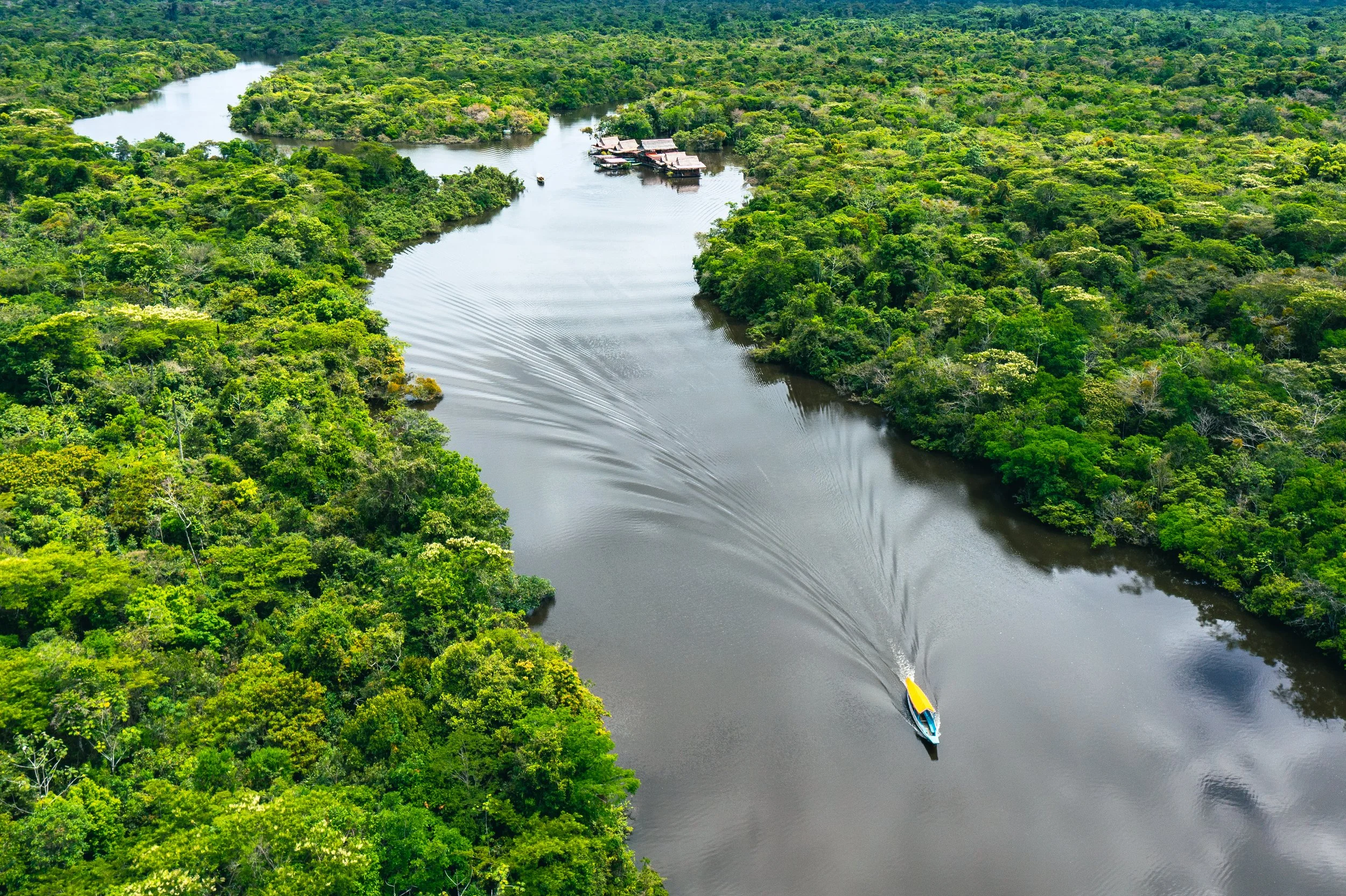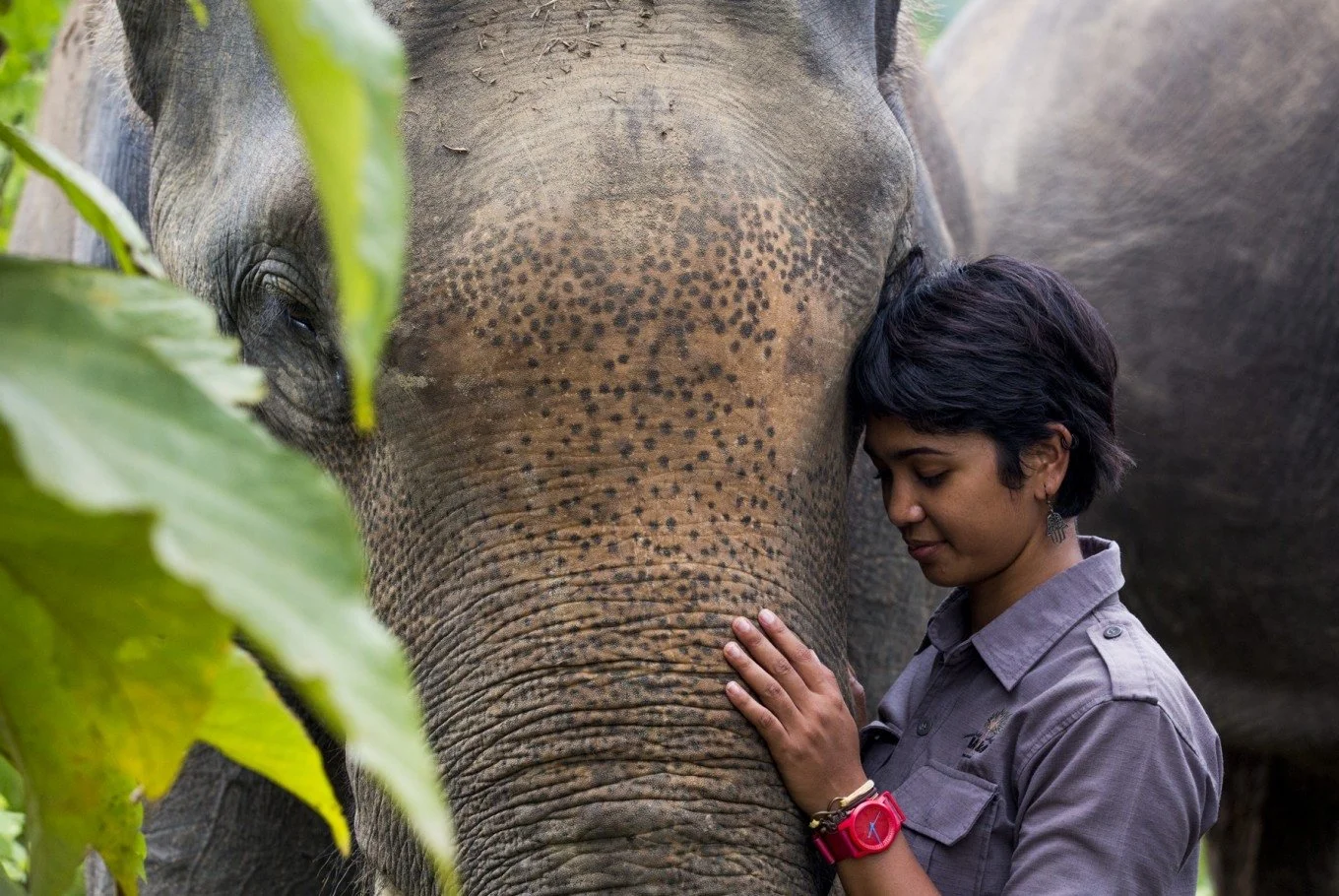GC Featured in Worth Magazine: Where Ancestral Knowledge Meets Modern Tech
Orignially published at worth.com by Caroline BienfangIndigenous communities in the Peruvian Amazon are fusing tradition and technology to protect territory, assert rights, and respond faster than ever.
An aerial view of the Rio Momon in the Amazon Rainforest near Iquitos, Peru, one of South America’s most biodiverse regions. Photo: © Curioso.Photography – stock.adobe.com
Deep in the Peruvian Amazon, Indigenous communities are reshaping what it means to lead on climate resilience. Armed with drones, satellite data, and machine learning, the Asháninka people are using cutting-edge technology to protect ancestral land from illegal logging and deforestation. But this isn’t just about tech—it’s a systems-level model of local empowerment, where the future of environmental stewardship is being shaped by those who’ve protected these forests for centuries.
Sequestering tens of millions of tons of carbon each year, the Amazon rainforest quite literally breathes life into our world. Over the past 50 years, approximately 18% of the Amazon rainforest has been cleared or deforested. Ongoing threats of displacement, land loss, and deforestation through methods such as illegal logging are among just a fraction of the daily activities that damage one of the Earth’s most vital ecosystems.
In a world where climate change has increasingly become one of the most significant global pressures, indigenous groups in the Peruvian Amazon rainforest have weathered the storm and strengthened their armies. In a fight that persists, pairing satellite surveillance and drone patrols has proven even more effective, thanks to the help of ecological stewardship. Among the nearly 10% of the world’s known species, the Asháninka people comprise about 55,000 individuals. Peru’s largest indigenous group in the Amazon resides in remote communities that span the Departments of Junín, Pasco, Huánuco, and Ucayali.
Equipped with ancestral knowledge and guided by generations of spiritual and ecological wisdom, the Asháninka people have long fought for the protection of their land. Since the Spanish Conquest and the violence that occurred during the Rubber Boom, they have stood as fierce protectors. The threat of climate change and illegal deforestation is the same devil in a different dress.
Today, they’re adding something new to that toolkit: technology.
Surveillance for Survival: The New Tools of Resistance
Peru holds the second-largest land area of the Amazon rainforest. However, unlike Brazil, “Peru does not always provide the same level of legal protection and structural support for Indigenous peoples,” said Suzanne Pelletier, Executive Director at Rainforest Foundation US. An integral part of integrating this technology is land conservation, but more importantly, it provides benefits to local communities in their ongoing battle for land rights. “This makes it vital for Indigenous communities to access legal, social, and technological resources to demand recognition and respect for their rights…,” said Pelletier.
Matt Finer is Senior Research Specialist & Director of Monitoring of the Andes Amazon Program (MAAP) at Amazon Conservation. First launched in 2015, MAAP was developed by Amazon Conservation (U.S.), in alliance with sister organizations in Peru (Conservación Amazónica-ACCA) and Bolivia (Conservación Amazónica-ACEAA). The technology offers “real-time monitoring”. MAAP quickly detects illegal deforestation using high-resolution satellite images (0.5 to 3 meters). It combines automated alerts from Global Forest Watch with detailed image analysis to precisely and rapidly monitor the Amazon. Unlike selective logging, MAAP primarily focuses on clear-cut deforestation.
The power of these tools lies in their ability to work cohesively. MAAP combines real-time deforestation alerts from Global Forest Watch with high-resolution satellite imagery and uses satellite tasking to zoom in on suspected areas of activity. “There is now the possibility for Indigenous leaders to monitor their communities and territories, no matter how large and remote, without getting in harms way,” said Finer.
For the past three years, MAAP has monitored the Asháninka CR and adjacent Otishi National Park every month, reporting on more than 100 confirmed instances of forest loss. The reports are sent monthly to Global Conservation, which then shares them with the Asháninka communities involved in its ecoguard (local ecoguards) program.
With boots on the ground, Global Conservation is providing drones to document deforestation in real time and even supplies trucks, fuel, and food for the Asháninka Community Ecoguards during multi-day patrols. “Never before have Peru’s national parks worked so closely with all key governmental organizations and their combined resources in partnership with local communities to stop the environmental damage of its National Parks,” said Jeff Morgan, Executive Director at Global Conservation.
“All Asháninka patrol teams have GPS and smartphones to document their patrolling and findings related to illegal land clearing and logging,” said Morgan. “They receive ongoing training in SMART patrols by Global Conservation,” he added.
In just one year, their efforts have grown dramatically, now covering more than 2,600 kilometers of forest terrain. Within this time, community monitors have uncovered about 48 instances of illegal logging, land clearing, and even unmarked airstrips. These discoveries have resulted in six arrests in 2025.
“Due to Peru’s long history of establishing national parks and Indigenous territories, we now need to work harder together to protect them,” added Morgan.
Machine learning has become an integral part of the artillery that equips indigenous communities within Peru’s Amazon. Developed by the University of Sheffield, the mechanism uses data from satellites to pinpoint exact areas that are most vulnerable or have fallen victim to the illegal removal of its most valuable trees, providing tangible evidence of unlawful activity.
“The machine learning models take this large dataset of pixel values – where we have labelled them as being from a logged or an unlogged location – and it tries to find relationships amongst all the values,” said Matthew Hethcoat, Research Scientist at the Canadian Forest Service. Hethcoat was among the scientists who helped to develop this machine learning algorithm from free and open satellite data from Google.
Within its first year, the tools were used to monitor 1.3 million hectares and halted $8 million worth of illegal timber from being exported. By 2024, coverage had grown by 500 million hectares, resulting in an increase in detection, which blocked approximately $11 million worth of stolen wood from being sold.
Local Eyes, Global Tools
The exceptional ethics and dedication to preservation are evident to many who venture to these rural areas of the Peruvian Amazon. Young, aspiring indigenous leaders, elders, women, and men have worked hard to educate themselves on using smartphones to map illegal roads, operate high-tech drones that hover above this ancient land, and community monitors who sync digital alerts with foot patrols. As the threat of climate change escalates, the fusion of sophisticated technology and local stewardship is shifting power. It is putting stewardship back into the hands of those who know it best. “The use of technology by Indigenous monitors allows them to know and watch over their territories in a completely new way,” said Suzanne Pelletier, Executive Director at Rainforest Foundation US. Allowing Indigenous groups to exercise rightful autonomy over their land is crucial—not only because it is rightfully theirs, but also because of their deep spiritual and ancestral knowledge.
“Remote sensors can show changes in forest cover, but only those who know the forest can explain what is causing them,” said Pelletier.
Rainforest Foundation US’s model centers on Indigenous territorial leadership and builds on existing community-led monitoring systems. Rather than deploying solely foreign forces, this structure uses the strength of the community and the fierce capacity of local knowledge to protect the land. In Peru, the Rainforest Foundation US (RFUS) partners closely with Indigenous communities and their leaders to expedite the process of securing official land titles.
Today, the Rainforest Foundation US supports five information hubs in Loreto and plans to add two more this year in Ucayali, specifically in the Purús and Yurúa territories. “When communities generate and validate their maps, they speed up the land-titling process with the government and reduce the risk of boundary conflicts,” said Pelletier.
Research from Columbia University, featured in the Proceedings of the National Academy of Sciences, found that affirming Indigenous land rights plays a vital role in combating the climate crisis. “In communities equipped with satellite alerts and training, deforestation decreased by 52% in 2018 and 21% in 2019 compared to those without access to these tools,” said Pelletier.
People Power: Forest Protection’s Next Generation
While technology can be credited for the transformation of the forest and its protection, it’s also the people who are taking that action. The emergence of young men and women who have dedicated their youth to learning to operate highly technical systems is not only tactile but woven into the fabric of the community and rising leadership. This work is ushering in a new model of resilience in forest protection.
As monitors, Indigenous women are breaking gender barriers and taking on community leadership roles.
Of those communities, one group in particular is emerging as a quiet powerhouse: women. In Peru’s Indigenous territories, women are not only participating in forest monitoring—they’re leading it.
“We have also seen deep impacts on local leadership. One of our female monitors became the first woman to be elected as a community leader, something that makes us incredibly proud,” said Pelletier.
Across the Amazon, youth and women are stepping into new roles as technologists, mappers, and ecoguards. They’re utilizing highly skilled technological devices to fly drones, interpret satellite data, and coordinate with government agencies to respond to threats on the ground.
Technology has been the catalyst, but the driving force is the people themselves. By fusing ancestral knowledge with real-time monitoring technology, it’s not just shaping how the land is protected, but who is leading the charge. It’s a model of climate resilience rooted in autonomy, memory, and innovation.
Despite the steadfast role of Indigenous-led monitoring and tech-driven patrols, one significant piece of the puzzle wavers: global investment. “Today, there is no international funding mechanism to protect endangered forests in developing countries,” said Morgan.
“This is a huge problem and a relatively cost-effective solution to climate change – protecting our largest, intact tropical forests can help solve 20-30% of the climate crisis,” said Morgan.
In a region long defined by extraction, the Asháninka are flipping the script—transforming the Amazon from a resource to be exploited into a network to be protected. Their tools may be modern, but their mission is ancient: to safeguard the land for the people and for the planet. If the world is serious about solving climate change, it might be time to start listening to the forest.














